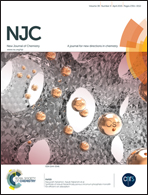Targeted doxorubicin delivery to hepatocarcinoma cells by lactobionic acid-modified laponite nanodisks†
Abstract
In this study, we covalently conjugated polyethylene glycol-linked lactobionic acid (PEG-LA) onto the surface of laponite (LAP) nanodisks for the targeted delivery of doxorubicin (DOX) to liver cancer cells. LAP nanodisks were firstly modified with 3-aminopropyldimethylethoxysilane to introduce amino groups on the surface, and then PEG-LA were successfully conjugated to form targeted LM-PEG-LA nanodisks via EDC chemistry. Finally, the anticancer drug DOX was encapsulated into the synthesized nanocarriers with an exceptionally high loading efficiency of 91.5%. In vitro release studies showed that LM-PEG-LA/DOX could release drugs in a sustained manner with a higher speed under acidic conditions than that under physiological ones. MTT assay results proved that LM-PEG-LA/DOX displayed a significant higher therapeutic efficacy in inhibiting the growth of hepatocellular carcinoma cells (HepG2 cells) than untargeted ones at the same DOX concentration. The targeting specificity of LM-PEG-LA/DOX was further demonstrated by flow cytometric analysis and confocal laser scanning microscopy. The developed LA-modified LAP nanodisks could serve as a targeted carrier for efficient loading and specific delivery of different anticancer drugs to liver cancer cells.


 Please wait while we load your content...
Please wait while we load your content...